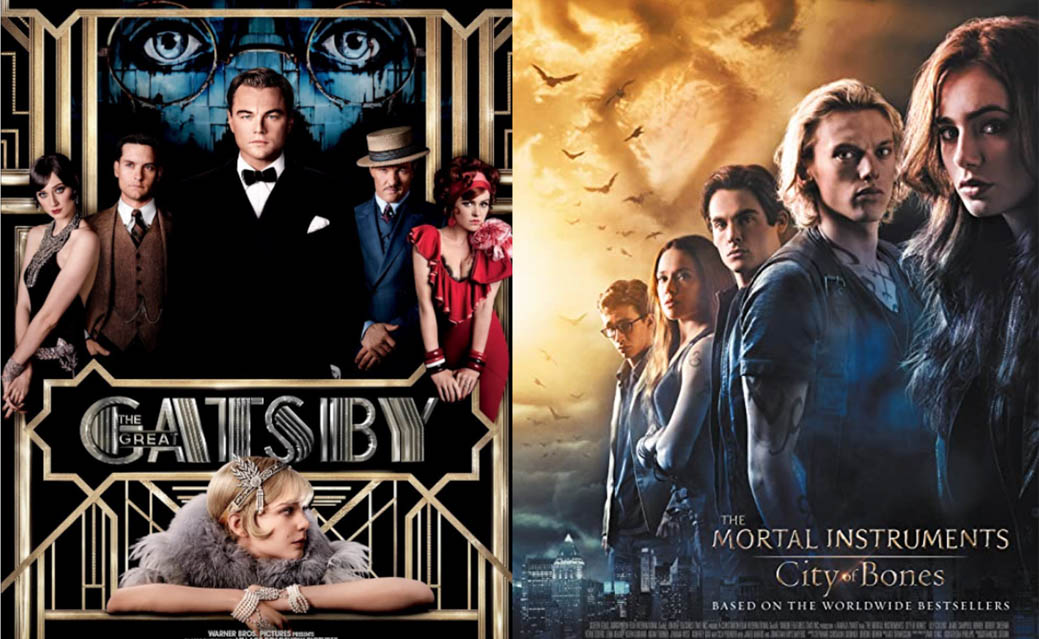The best and worst book-to-film adaptations
While The Great Gatsby was iconic in both book and film, The Mortal Instruments failed to translate on the big screen.
Best Adaptation—The Great Gatsby (2013)
Serena Uribe
“A little party never killed nobody,” sings Fergie in a song from one of the best book-to-film adaptations.
I know a lot of people might disagree, but in my opinion, Baz Luhrmann’s 2013 rendition of The Great Gatsby is the best version. Starring a stellar cast of Leonardo DiCaprio, Tobey Maguire, Carey Mulligan, and Joel Edgerton, The Great Gatsby reworks the 1925 novel by F. Scott Fitzgerald through a flamboyant, vivacious, lens.
The adaptation follows the original storyline of the novel and hardly misses a beat. Though the book has been adapted four times, it is Luhrmann’s unique style of cinematography and directing that draws viewers in. Unlike its subdued counterparts, Luhrmann’s version is fast-paced, colourful, and glamorous. The deliberate choice of this lively film style evokes the splendor and decadence of the roaring twenties and art-deco style. The film’s parties, drama, mystery, and cinematography keep you in awe, and of course, everyone loves a good love story.
Featuring a contemporary soundtrack that is also part of the plot’s ensemble, the adaptation takes a modernized twist. Songs by Jay-Z and Lana Del Ray are embedded in party scenes or dramatic encounters. This addition of contemporary music contributes to the film’s vivacity and heightens the desired effect of visual excess and grandeur.
Good narration and inner dialogue are always appreciated, and like the novel, the film uses first-person narration by the protagonist, Nick Carraway (played by Maguire). The speed and moments in which Nick narrates the events of his 1922 summer magnify the drama while inviting us within his psychic space.
The performances of the cast are also applaud-worthy, as they truly maximize the potential of their roles. No actor draws their character down. The Great Gatsby’s already tangled plot engenders much intrigue, making it an ideal novel to write for the big screen. Luhrmann’s adaptation elevates every aspect of the plot and leaves no room for dullness. While the film has been criticized for over-exaggeration, I think it livens and enhances the storyline. After all, a little party never killed nobody, right?
Worst Adaption—The Mortal Instruments: City of Bones (2013)
Dagale Mohammed
Would you like to learn a not-so-fun fact? The Mortal Instruments series by Cassandra Clare is based on Harry Potter fanfiction that Clare wrote herself, which got her banned from fanfiction.net. I do not know about you, but I have read some gnarly fanfiction and never heard of a fanfiction author being kicked off fanfiction.net. Clare’s first foray into original writing is The City of Bones, the first book in the series, which was adapted into The Mortal Instruments: City of Bones film, a boring mess.
In the story, Clary Fray (played by not-redhead-enough Lily Collins in the movie) spends an evening in New York City with her best friend who is totally not in love with her, Simon (Robert Sheehan). They head to Club Pandemonium where Clary witnesses a murder. The strange thing is, there is nobody and no one else can see the murderer except her. Clary is then drawn further into the magical world of the Shadowhunters by bad boy Jace Wayland (Jaime Campbell Bower). The plot has all the fixings of your run-of the-mill YA fantasy venture: Angels! Demons! Vampires! Maybe incest!
It is a fun, flawed romp around the magical underworld of New York City. The author includes a lot in this novel from random side quests to a lot—and I do mean a lot—of lore. This, though, can be forgiven because the book is engaging. As an alumna of the YA wave of the late 2000s, City of Bones remains one of the more memorable reads. However, the film’s dialogue is clunky, particularly when world-building. Even worse, Clary feels like an onlooker in a story where she is the main character. In Harry Potter, there is no denying that Harry is average, but he still actively participates in the story by making decisions that move the plot forward. Similarly, Clary’s character drives the book’s plot, but she fails to do so in the film; she takes a backseat because of the poor dialogue, decent Computer-Generated Imagery, and weird plotline. This adaption was poorly made, and it is no surprise that the sequel was cancelled. If the plot entices you, just read the book.


